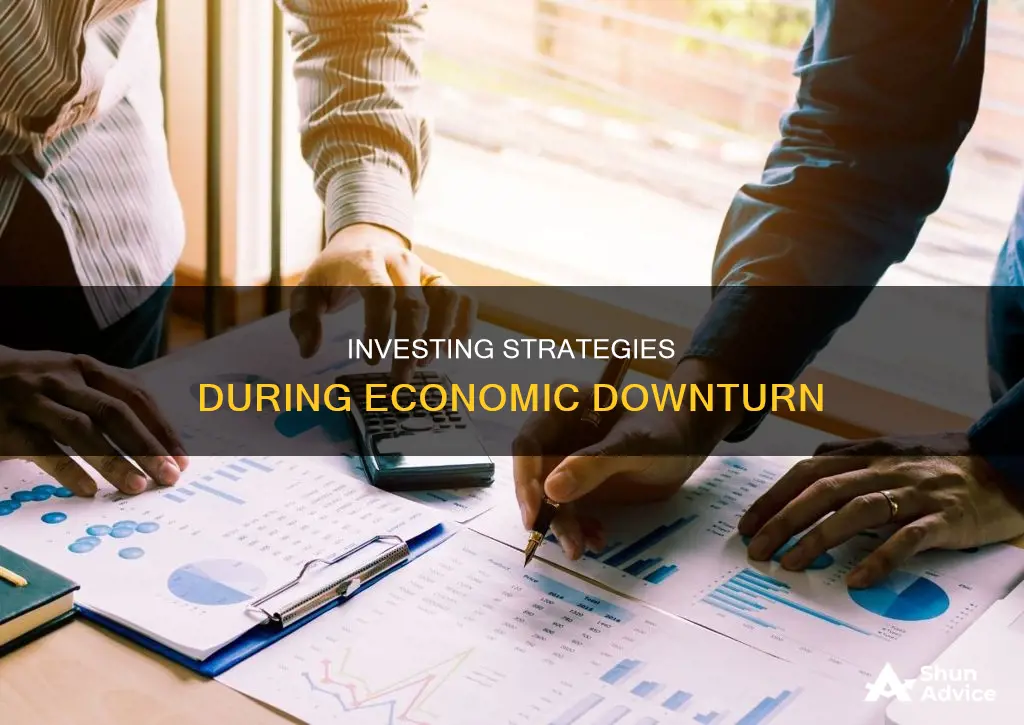
During an economic downturn, people often have access to more assets for less money. While it can be tempting to sell off investments and keep cash reserves, this is rarely a good idea as holding cash means losing money as inflation eats away at savings. Instead, it's better to stay invested and stick to a long-term investment plan that aligns with your risk tolerance, goals and timeline.
Some sectors that tend to do well during economic downturns include healthcare, information technology, utilities, consumer staples and communication services.
| Characteristics | Values |
|---|---|
| Cash reserves | It is recommended to have plenty of emergency savings, covering 3-6 months of living expenses |
| Long-term investment | Avoid selling investments to get cash, instead, stick to a long-term investment plan that aligns with your risk tolerance, goals and timeline |
| Dollar-cost averaging | Buy a fixed amount of an investment regularly, regardless of the current price |
| Quality assets | Seek out quality across asset classes, such as low beta, high return on investments and low leverage |
| Dividend stocks | The best dividend stocks can cushion your portfolio during recessions |
| Actively managed funds | Most actively managed funds outperformed their peers by 4.5% to 6.1% per year in down markets |
| Bonds | Bonds tend to do well during recessions, but stick to investment-grade bonds to guard against rising defaults |
| Uncorrelated assets | Truly uncorrelated asset classes, such as royalties, insurance-linked securities and carbon credits, may perform well when traditional asset classes struggle |
| Defensive stocks | Consumer staples stocks tend to be insulated from economic ups and downs, as they sell essential goods and services |
| Healthcare stocks | Healthcare is an essential service that people require regardless of the state of the economy |
| Precious metals | Gold and silver are typically resilient during downturns and can act as a hedge against inflation |
| Crypto | Crypto is a high-risk, high-reward investment that can be less vulnerable to economic turbulence due to its limited supply |
What You'll Learn

Invest in consumer staples
Consumer staples are essential goods and services that people need and use daily, such as food, beverages, household goods, and personal care items. This sector also includes pharmaceutical drugs and companies that produce and grow crops.
Consumer staples are non-cyclical, meaning they are always in demand, regardless of the economic climate. As such, they are impervious to business cycles. People tend to demand these products at a constant level, no matter the price.
The consumer staples sector has outperformed all but one sector since 1962. According to the S&P Dow Jones Indices, for most of the 10 years ending April 26, 2021, the consumer staples sector returned 8.20% annually, compared to 11.86% for the S&P 500 over the same period.
During economic downturns, people may cut back on non-essential items, but they will still need to buy daily essentials. This makes the consumer staples sector less volatile and more attractive to investors seeking stability and consistent returns.
Some examples of companies in this sector include:
- Procter & Gamble
- Coca-Cola
- Walmart
- L'Oreal
- Johnson & Johnson
- PepsiCo
- Nestle
- Unilever
- B&G Foods
- Kimberly-Clark
- Phillip Morris
There are a few ways to invest in the consumer staples sector:
- Purchasing stocks of individual consumer staples companies
- Buying mutual funds or exchange-traded funds (ETFs) that specialise in the sector, providing exposure to a diversified portfolio of consumer staples companies
- Fractional shares, or slices, which allow investors to buy stocks without purchasing the whole share
Some risks to investing in the consumer staples sector include:
- Sensitivity to changes in commodity prices, such as the cost of raw materials
- Increased competition
- Regulatory changes, particularly those related to food safety, packaging, and labelling
- Shifts in consumer behaviour, such as a preference for cheaper brands or generic products, or a move towards healthier or more sustainable products
Where to Invest: Personal Preferences
You may want to see also

Focus on defensive stocks
Defensive stocks are stock investments that are relatively less volatile and more stable compared to other types of stocks. They are called defensive stocks because they tend to hold up well during market downturns, making them a defensive play against crisis times. Defensive stocks are investments that tend to perform well during times of economic uncertainty.
Defensive stocks are characterised by their low beta. Beta is a measure of a stock's volatility in relation to the overall market. A beta of 1 suggests that the stock's price will move in tandem with the market, while a beta greater than 1 indicates higher volatility and the potential for larger gains or losses. In contrast, a beta lower than 1—which defensive stocks have—reflects lower volatility and less risk.
Defensive stocks typically generate steady cash flows and have a history of consistent dividend payments, making them attractive for investors seeking stable returns. During times of economic uncertainty or market downturns, defensive stocks may outperform growth stocks or high-beta stocks. This is because investors often pile into defensive investments as a safe haven during turbulent times.
Defensive stocks are an important part of a well-diversified investment portfolio. While they may not offer as much growth potential, their defensive nature makes them an attractive option for risk-averse investors.
The main defensive sectors are utilities, consumer staples, and healthcare. These sectors are considered essential and typically maintain their income streams and overall stability even when the market is volatile.
Examples of defensive stocks include:
- Procter & Gamble
- Johnson & Johnson
- Philip Morris International
- Coca-Cola
- L'Oreal
- Walmart
Bankers: Social Butterflies or Lone Wolves?
You may want to see also

Invest in healthcare
Investing in healthcare during an economic downturn can be a stable and safe option. Healthcare is a staple service that people cannot survive without, and it is relatively recession-resistant. People will always require medical attention, medicines, and services, regardless of the state of the economy.
During an economic downturn, people's economic positions determine their use of healthcare services. This means that the most vulnerable groups, such as the unemployed, those with low educational levels, and migrants, are significantly affected. These groups tend to have greater healthcare accessibility inequalities and unmet needs. Therefore, it is essential to invest in strategies that improve access to healthcare for these vulnerable populations.
Healthcare systems themselves can be impacted by economic downturns, with austerity measures leading to reduced health budgets, workers' wages, healthcare provisions, and pharmaceutical spending. These measures can have a detrimental effect on the population's health, as seen during the 2008 economic crisis in Europe. As a result, there may be opportunities to invest in new forms of health planning, such as hospitalisation at home, new models of integrated care, and pharmaceutical management.
Additionally, it is worth noting that funding for early-stage companies and digital health appears to have cooled during the current economic downturn. However, there remains a strong interest in health tech, as it can help solve ongoing challenges in the healthcare industry, such as workforce shortages. When considering companies for investment, look for those with a demonstrated return on investment or a proven improvement in quality and compliance.
Overall, investing in healthcare during an economic downturn can be a stable option due to the essential nature of the industry. By focusing on strategies that improve access for vulnerable populations and addressing the impact of austerity measures on healthcare systems, investors can make a positive impact while also benefiting from the relative stability of the healthcare sector.
Wealthy Secrets: Where the Rich Invest
You may want to see also

Invest in gold and silver
Gold and silver are precious metals that have been used as currency, investments, and symbols of wealth for thousands of years. They can be a good investment during an economic downturn due to their history as a store of value, low correlation with volatile financial markets, and their ability to hedge against inflation.
Gold vs Silver
When deciding whether to invest in gold or silver, there are several factors to consider:
- Silver is more tied to the global economy. It is used heavily in industry and high technology, so its price is more sensitive to economic changes.
- Silver is more volatile than gold, with price volatility two to three times greater than gold on a given day.
- Gold is a more powerful diversifier than silver. It has a very low correlation with other major asset classes and is less affected by economic declines due to its limited industrial uses.
- Silver is currently cheaper than gold, making it more accessible to small retail investors.
Ways to Invest in Gold and Silver
There are several ways to invest in gold and silver:
- Physical metals: Gold and silver can be purchased as physical bars and coins, either held in a brokerage account or stored yourself. However, this option may involve additional costs for storage and insurance, and you may pay a premium over the metal spot price due to manufacturing and distribution markups.
- Exchange-Traded Funds (ETFs): ETFs allow investors to gain exposure to gold and silver without the responsibility of storing physical assets. You can buy shares and hold them in a traditional brokerage account. While ETFs provide liquidity and diversification, they do not give investors access to the underlying metals, and some are taxed as collectibles.
- Mining stocks and funds: You can invest in companies that mine gold and silver, or mutual funds that hold portfolios of these miners. This option provides exposure to the mining industry, which is heavily influenced by the market price of the metals.
- Futures and options: Gold and silver can be traded via financial derivatives like futures and options, which offer leverage and the potential for higher returns, but also come with higher risks.
Benefits and Drawbacks
Gold and silver can be a good investment during an economic downturn, but there are some benefits and drawbacks to consider:
- Gold and silver tend to hold their value or even increase in price during economic downturns as investors flock to the safety of precious metals.
- Gold and silver can diversify your portfolio and spread out your risk across multiple asset classes.
- Gold is considered a liquid investment as it is always in demand and can be easily sold when needed.
- Gold does not generate income or dividends, so its returns rely solely on price appreciation.
- Physical gold and silver may require additional costs for storage and insurance, and there is a risk of theft if stored at home.
- Gold and silver may not provide as many returns as higher-risk assets over the long term.
In conclusion, investing in gold and silver can be a good strategy during an economic downturn, but it is important to consider the benefits and drawbacks and determine how these investments fit into your overall financial goals and risk tolerance.
Diversifying Savings: Beyond Stocks and Bonds
You may want to see also

Invest in yourself
Investing in yourself is always a good idea, but it can be particularly beneficial during an economic downturn. If you lose your job during a recession, you can rebound by investing in yourself to gain additional knowledge or skills that could help you get a better job.
- Education and skill development: Consider going back to school or enrolling in courses to upgrade your skills or learn new ones. This could help you become more competitive in the job market or pivot to a new career path.
- Pay down debt: If you're concerned about your job security during a recession, focus on paying down your debt. Reducing your financial obligations will give you more flexibility and peace of mind during an economic crisis.
- Networking and mentorship: Investing in networking opportunities and mentorship can help you build valuable connections and gain access to new opportunities. A mentor can also help you navigate career challenges and avoid costly mistakes.
- Personal development: Invest time and resources into your personal growth and well-being. This could include activities such as therapy, coaching, or self-help resources that help you develop resilience, improve your mindset, and enhance your ability to handle stress.
- Side hustles and odd jobs: If you find yourself strapped for cash during a recession, consider taking on additional sources of income through side hustles or odd jobs. This can help you supplement your primary income and build financial resilience.
Remember, investing in yourself is an ongoing process that can provide long-term benefits. By gaining knowledge, skills, and connections, you can improve your career prospects, increase your earning potential, and enhance your overall well-being.
Retirement Planning: 401(k) Investors Count
You may want to see also
Frequently asked questions
It can be, but it depends on your financial position and attitude. You should not compromise your near-term financial security for long-term gain.
Consumer staples, healthcare, information technology, and defensive industries such as utilities, healthcare, and consumer staples.
Growth stocks, profitless companies with high growth prospects, and speculative stocks.
Focus on quality companies, take a long-term approach, and invest incrementally to take advantage of lower stock values.
Reassess your expenses and increase your savings, invest in things that increase in value over time, and diversify your investments.







